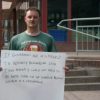KJIPUKTUK (Halifax) – This Monday I attended a protest at Grand Parade in Halifax against Coming Out Ministries.
During the week of July 20-28, the Maritime Conference of the Seventh-day Adventist Church will be hosting Coming Out Ministries, a group of “redeemed” “ex-gay” spiritual leaders, at their “Campmeeting 2018” in Pugwash. They plan to share personal accounts of how they were “freed from the chains of homosexuality”, “plucked from the burning”, “redeemed” of being gay, lesbian, bisexual or queer, and “cured” or their transgender or genderqueer identity through prayer, devotion and conversion therapies.
The protest at Grand Parade was organized by the Nova Scotia Rainbow Action Project, The Youth Project, and Halifax Pride, with the hope of convincing the Seventh-day Adventist Church to uninvite Coming Out Ministries from their annual Campmeeting.
The protesters also want to see Nova Scotia pass a law to ban the gay conversion therapy. There was a petition to sign, and several speakers, including Julie Hollenbach and Susanne Litke from NSRAP, Kate Shewan, executive director of The Youth Project, and social worker Robert Wright.
After the scheduled speakers, they opened the microphone up for anyone in the crowd who wished to speak. At that point, I got up and gave a short speech on the connection between gay conversion therapy and autistic conversion therapy, also known as Applied Behavioral Analysis (ABA).
To understand the connection, I first have to give some background.
What is ABA?
Applied Behavioral Analysis has long been considered the “gold standard” of “intervention” for autism. As defined by the Behavior Analyst Certification Board,
“Behavior Analysis is the scientific study of principles of learning and behavior. Two primary areas of study include:
Experimental Analysis of Behavior: The basic science of the discipline and has, over many decades, accumulated a substantial and well-respected body of research literature on how behavior is learned and changes over time. The experimental analysis of behavior is the scientific foundation of Applied Behavior Analysis.
Applied Behavior Analysis (ABA): A systematic approach for influencing socially important behavior through the identification of reliably related environmental variables and the production of behavior change techniques that make use of those findings. Practitioners of behavior analysis provide services consistent with the dimensions of ABA.”
Supporters of ABA say that it’s meant to increase “positive” skills and behaviors and reduce or eliminate “problem” behaviors in autistic children. Autistic children are often signed up for ABA or derivatives of it as soon as they’re diagnosed. Their parents are usually told their kids need this “therapy” right away for a good start in life.
However, an ever-increasing number of autistic adults, non-autistic parents of autistic children, and even some former therapists are calling this idea into question. They say that ABA is harmful, traumatizing and abusive, that it treats autism as a problem to be fixed, and that its ultimate goal is to make autistic children pass as non-autistic.
Moreover, they say that when autistic people’s natural ways of communicating, moving, and interacting with the world are suppressed, it can cause serious, long-lasting harm.
Sound familiar?
Roots of ABA: “You have to build the person”
The “founding father” of ABA is generally considered to be Ivar Lovaas, a Norwegian-American psychologist and professor at the University of California, Los Angeles (UCLA). He believed that autistic children were not even people. As Lovaas once said,
“You see, you start pretty much from scratch when you work with an autistic child. You have a person in the physical sense – they have hair, a nose and a mouth – but they are not people in the psychological sense. One way to look at the job of helping autistic kids is to see it as a matter of constructing a person. You have the raw materials, but you have to build the person.”
Lovaas developed what he believed to be a comprehensive way to “build the person” and called it Applied Behavioral Analysis. His recommendation was that autistic children receive 40 hours of ABA therapy a week. One of his most important goals was to shape and mold their behaviors so they would appear more like “typically-developing” children. Lovaas felt this was the only way autistic children would ever be able to learn anything, and he would often employ harsh aversive techniques such as withholding affection, withholding food, physical punishments, and even electric shocks.
The strong and punitive aversives Lovaas suggested may not be as widely used today, but the reliance on rewards and punishment continues in other “therapies” and “interventions” that use the principles of ABA, which I’ll discuss in a future article. Some therapists argue that the more “modern” forms of ABA are more humane approaches, but they are nonetheless still based in the idea that autistic ways of being in the world are unacceptable and must be eradicated.
So what’s the connection to gay conversion therapy?
Well, Lovaas was also substantially involved in the Feminine Boy Project, which has strong connections to what is today known as gay conversion therapy. Psychologist George Rekers, a key figure in the world of conversion therapy (and co-founder of the notoriously anti-gay Family Research Council), used Lovaas’s techniques to treat so-called “deviant sex-role behaviors” in male children.
And when you think about it, even if Lovaas had no connections at all to gay conversion therapy, ABA has enough similarities to gay conversion therapy that many autistics refer to it as “autistic conversion therapy”.
There’s more waves to be made
I am very grateful to the organizers of the protest for doing it, and I’m eternally thankful for the chance to be able to speak. My presentation was well-received by everyone, and a few people came up to speak with me afterward. All I can say is, there’s more waves to be made against ABA in Canada!
Which is why my next article will take a closer look at ABA in Canada, especially Nova Scotia, who’s fighting back against it, and what we can do instead.
See also:
If you can, please support the Nova Scotia Advocate so that it can continue to cover issues such as poverty, racism, exclusion, workers’ rights and the environment in Nova Scotia. A paywall is not an option, since it would exclude many readers who don’t have any disposable income at all. We rely entirely on one-time donations and a tiny but mighty group of dedicated monthly sustainers.





Every time we celebrate another state banning conversion therapy on minors as harmful and dangerous, I try to note that it’s still widely considered the therapy of choice for autistic children.
This article is discussing the work of Lovaas as if it is a contemporary source on ABA. These writings are around 50 years, there are no current leaders in our field that would describe a people in this manner. Practitioners now must adhere to a strict ethics code including respecting the cultures of others thus no longer treating so called gender ‘deviance.’ Our science teaches skills that are important to the learner and their family and our work begins by reinforcing first not using aversive consequences. I do not see any citations to the studies discussed of those opposed to ABA.
“I do not see any citations to the studies discussed of those opposed to ABA.”
There are a TON of writings by those opposed to ABA. You just need to find them. There is a very large quantity of first-hand accounts from ABA survivors, as well as from neurotypical parents of autistic children, and even some former therapists.
It is fairly common for professionals to dismiss these accounts as “merely anecdotal”, but that attitude needs to stop yesterday. The truth is, in the mainstream discourse, research from the medical and psychological establishments can often take precedence over the lived experiences of those they claim to support.
If you’re asking for research studies and hard data, look no further than this recent one from autistic researcher Henny Kupferstein. And it focuses on the so-called “good” or “modern” ABA, and not the kind that uses aversives.
https://hennykdotcom.files.wordpress.com/2018/02/aia_evidence-of-increased-ptsd-symptoms-in-autistics-exposed-to-applied-behavior-analysis.pdf
There is also this published research article that demonstrates training by repetition actually prevents learning for autistic people. Training by repetition is a common technique and a key part of ABA.
https://www.cmu.edu/news/stories/archives/2015/october/repetition-and-autism.html
With regard to the vast amount of lived experience evidence which is written about in the personal blogs of autistic people, we should value their perspectives and not dismiss their experiences simply because they do not validate the limits of current research.
There’s also this brand new piece in the Canadian Journal of Disability Studies:
http://cjds.uwaterloo.ca/index.php/cjds/article/view/423/664
100% agree
I have developed a cognitive approach that totally counters ABA, which I describe in my recent book “Uniquely Normal: Tapping the Reservoir of Normalcy to Treat Autism.” Steve Siberman wrote about my book, in fact it’s the first thing you see when you open my book!, that my method “avoids the traumatizing methods of ABA.” Please post more studies exposing ABA.
Does your book help with issues like grounding and unsafe behaviors?
Autism doesn’t need to be treated! It needs to be accepted!
Thank you so much for this. I’m really looking forward to reading more!
If I may jump in, with regards to unsafe behaviors, this list is the best I’ve ever seen on that topic.
https://neurodiversitylibrary.files.wordpress.com/2017/12/checklistwalyccolor.pdf
Just to be clear Lovaas is not the founder of ABA. He is a pariah in the community because he crossed tons of ethical boundaries. He just ran the first parametric analysis on early intervention treatment. His work was seminal, but far from the founder of ABA.
ABA is the only empirically validated approach to teach nonverbal individuals on the spectrum to talk. Sure there are downsides to it as there are to all treatments for anything. But if it is the author’s suggestion that we should just relegate them to the fringes of society so that we don’t harm their right to be themselves, then Alex might want to think about the implications of that. Should stop training babies to talk? Or helping those with depression or alcoholism and just let them be who they are? The logical extension of this author is that we shouldn’t help the blind with braille or teach sign language to the deaf either. Who knows if Alex would have ever been able to get up and make this statement or write this article without the ABA training the author presumably received.
Lastly, I would love some evidence about the ‘ever-increasing number of autistic adults, non-autistic parents of autistic children and even some former therapists are calling this idea into question.’ It’s easy to make claims, but not so easy to back them. The goal of ABA is meaningful participation in society. Hard for that to happen when you can’t communicate. It is certainly not to ‘eradicate’ those with autism. The author goes way too far. It is akin to making Alfred and Simon Binet responsible for Eugenics because IQ was used as a justification for the holocaust by the Nazis.
I would highly argue that is the father or founder of ABA – not by any means to ABA practitioners and academic programs today. Also, many sciences now – medical – psychiatry – behavioral and more – didn’t always start out using the most humane or modern treatments, hypotheses, and interventions. You can find horrible roots to so many human service professions and areas in these fields when you look back in history to even not so long ago. Sciences have evolved over time and what once was is just not anymore. Would you reccomened someone with anxiety or depression not seek treatment because of what people in the profession used to do? Because some were terrible indeed. Would you tell someone not to seek medical attention because of the procedures people used to use? Because some were wild indeed. The BACB has a very strict, specific code of ethics called PECCBA which is The Professional and Ethical Code of Conduct for Behavior Analysts – anyone can look it up and see that almost every section goes back to the main idea that the numerous rights – civil rights, confidential rights, and more – of the client are paramount. Anyone can use outdated theories and procedures and apply them to a current practice – but that’s just not accurate, fair, or responsible.
Pingback: Live de la Tronche en Biais sur la psychophobie : Mon avis (attention pavé). – Fina, la première femme toujours dans la Lune, dyspraxique et antivalidiste.